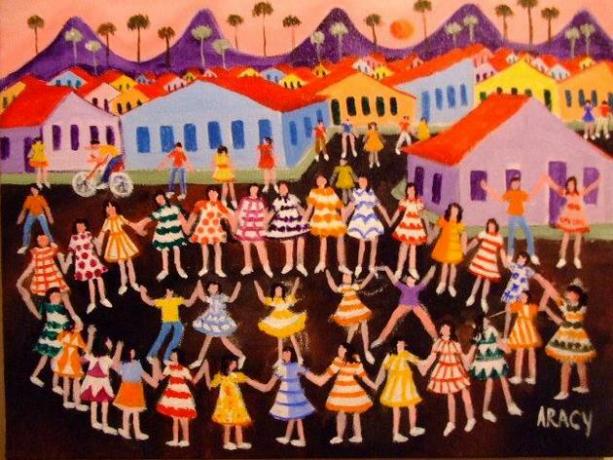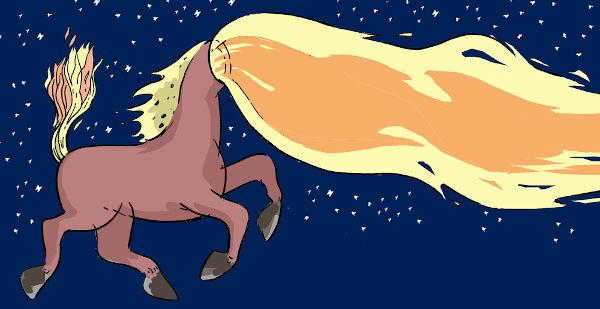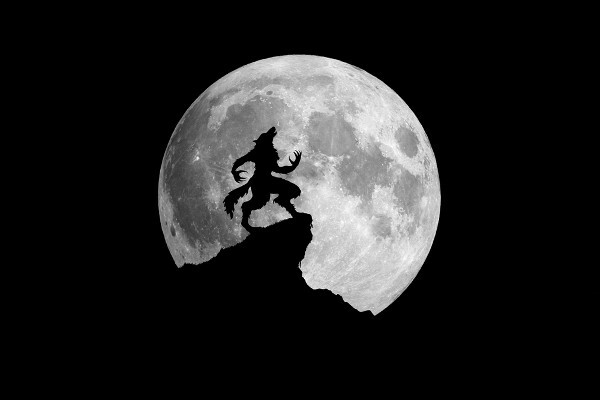At folk songs they are popular and traditional songs that are part of the wisdom of a people.
This type of musical manifestation is transmitted by oral tradition and, many times, the author of the same has been forgotten or not even known.
In any case, these anonymous musicians are hardly professionals, regardless of talent.
Check out the main folk songs that are part of Brazilian culture below:

white dove
White dove, what are you doing?
washing clothes for the wedding
I will wash myself, I will change
I go to the window to date
A young man in a white suit passed by
hat aside my boyfriend
I sent in
I told to sit down
spat on the ground
Clean up your bastard!
The Carnation and the Rose
The carnation fought with the rose,
under a balcony,
The nail was injured,
And the shattered rose.
The clove got sick,
The rose went to visit,
The harpsichord had a faint,
And the rose began to cry.
March Soldier
March Soldier
paper head
who doesn't march right
Go to the barracks
The barracks caught fire
the police gave a signal
Hail, hail, hail the national flag
Rosemary
rosemary, golden rosemary
who was born in the countryside
unseeded
Hi my love,
Who told you like that,
that the flower of the field
Is it the rosemary?
if this street were mine
if this street
if this street were mine
I sent
I had them tiled
with pebbles
With brilliant stones
For my
for my love to pass
slaves of job
Job's slaves
They played caxangá
Take it off, put it on,
let the zabelê stay
warriors with warriors
zigzig zá
warriors with warriors
zigzig zá
I went to Tororó
I went to Tororó to drink water, I didn't find it
I found it beautiful Morena
That in Tororó I left
enjoy my people
that one night is nothing
if not sleep now
will sleep at dawn
Oh! Ms. Maria,
Oh! Mariazinha, join this roda
Or you will be alone!
sailor only
Hi, sailor, sailor,
sailor only
Who taught you to navigate?
sailor only
It was the balance of the ship,
sailor only
It was the rocking of the sea
sailor only
my lemon my lemon tree
My lemon, my lemon,
My jacaranda tree,
Once, tindolele,
again, tandolala
The cockroach says it has
The cockroach says she has seven fillet skirts
It's a lie of the cockroach, it has only one
Ah ha ha ha ha ha, she has is only one
Cockroach says she has a velvet shoe
It's the cockroach's lie, its foot is hairy
Ah ra ra, Iu ru ru, her foot is hairy!
Cockroach says she has an ivory bed
It's the cockroach's lie, it's grass
Ah ha ha, kidney kidney kidney, she has it's grass
Live fish
How can the live fish
Living out of cold water?
How can the live fish
Living out of cold water?
How can I live,
How can I live,
Without yours, without yours,
Without your company?
the shepherds of this village
I'm already made fun of
the shepherds of this village
I'm already made fun of
for seeing me like this crying
without yours, without your company
the canoe capsized
the canoe capsized
For letting her turn,
It was because of Maria
who didn't know how to row
Siriri here,
Siriri over there,
maria is old
and want to marry
if i were a fish
And knew how to swim,
I took Maria
from the bottom of the sea
Ox black face
ox, ox, ox
Ox black face
Take this child who is afraid of making a face
no, no, no
don't catch him
He's cute, he cries poor thing
Puppy
Puppy is barking in the backyard
Shut up, Puppy, let my baby in
O Creole there! O Creole there, there!
O Creole there! I'm not the one who falls there!
I threw a nail in the water of heavy went to the bottom
The fish replied, live D. Peter the Second
melon chapel
Capelinha de Melão is from São João
It's Clove it's Rose it's Basil
Saint John is sleeping
Don't wake up!
Wake up, wake up, wake up, John!
Main Characteristics of Folk Music
- Spontaneous creation;
- Simplicity and repetition in the lyrics;
- Relationship with regional groups;
- It constitutes a cultural heritage;
- It varies depending on the region;
- Transmitted from generation to generation;
- It has no known author, being a "collective creation".

The folk melodies reflect the local style and preserve a regional cultural heritage for long periods as we find very old songs.
They can be performed by a soloist in one country or by a choir in another nation; be pentatonic in one location or use major scale in another. It is common to alternate between a soloist and a chorus in folk songs, where each one sings a verse from the stanza.
In any case, we recognize folk music by the way we act it out, learn it and spread it. It is almost always closely related to ethnic, regional and national groups.
Another striking feature of folk songs is the fact that they undergo changes when transmitted from interpreter to interpreter.
As there are many people involved in the creation of the songs, there is what is conventionally called "Collective Recreation". Thus, the regional function of songs originated in different places is consolidated.
Due to these affinities, folk song groups come together according to melodic families and the number of these melodic families can vary greatly in the same repertoire.
In this process, these melodies gradually change and generate regional and temporal variations.
In terms of conceptual classification, folk music is often opposed to that made by industrial society in the highest circles of urban culture.
This comparison is a fruit of the cultural descent of traditional or folk music, which is essentially rural, or, at the very least, greatly influenced by that medium.
Folk music is common in more isolated communities, that is, in places where the means of mass communication and other factors of globalization have not yet arrived at all to affect those populations.
Types of Folk Songs
Folk music covers almost all kinds of human themes. Generally, the letters are simple and have many repetitions, a very notorious feature that facilitates memorization.
Among these songs, there are the dance songs, considered the oldest of the popular songs and used to mark the rhythm of the dance.
So are the songs for children's dances and games, better known as circle songs.
A circle song that deserves to be highlighted is "Ciranda Cirandinha":
ciranda, cirandinha
Let's all go around!
let's turn around
Every now and then let's give
the ring you gave me
It was glass and it broke
The love you had for me
It was too little and it's over.
Other well-known folk songs are the lullabies, used to lull children's sleep. One of the most popular is the "Sleep Baby":
Sleep Baby
That the head comes to get
dad went to the farm
Mom in the coffee field
bogeyman
get off the roof
leave the baby
sleep peacefully
There are also the work songs, which are songs sung during the read. They can be sung individually or in groups.
Besides these, there are folk songs that are sung at wakes, war marches and other occasions.
Folklore Quiz
Read too:
- Southeast legends you can't miss
- Unmissable Legends of the South Region
- Lullabies - Folklore
- what is folklore


